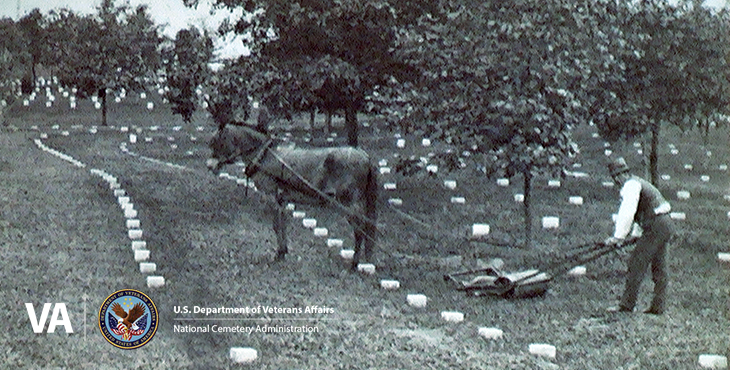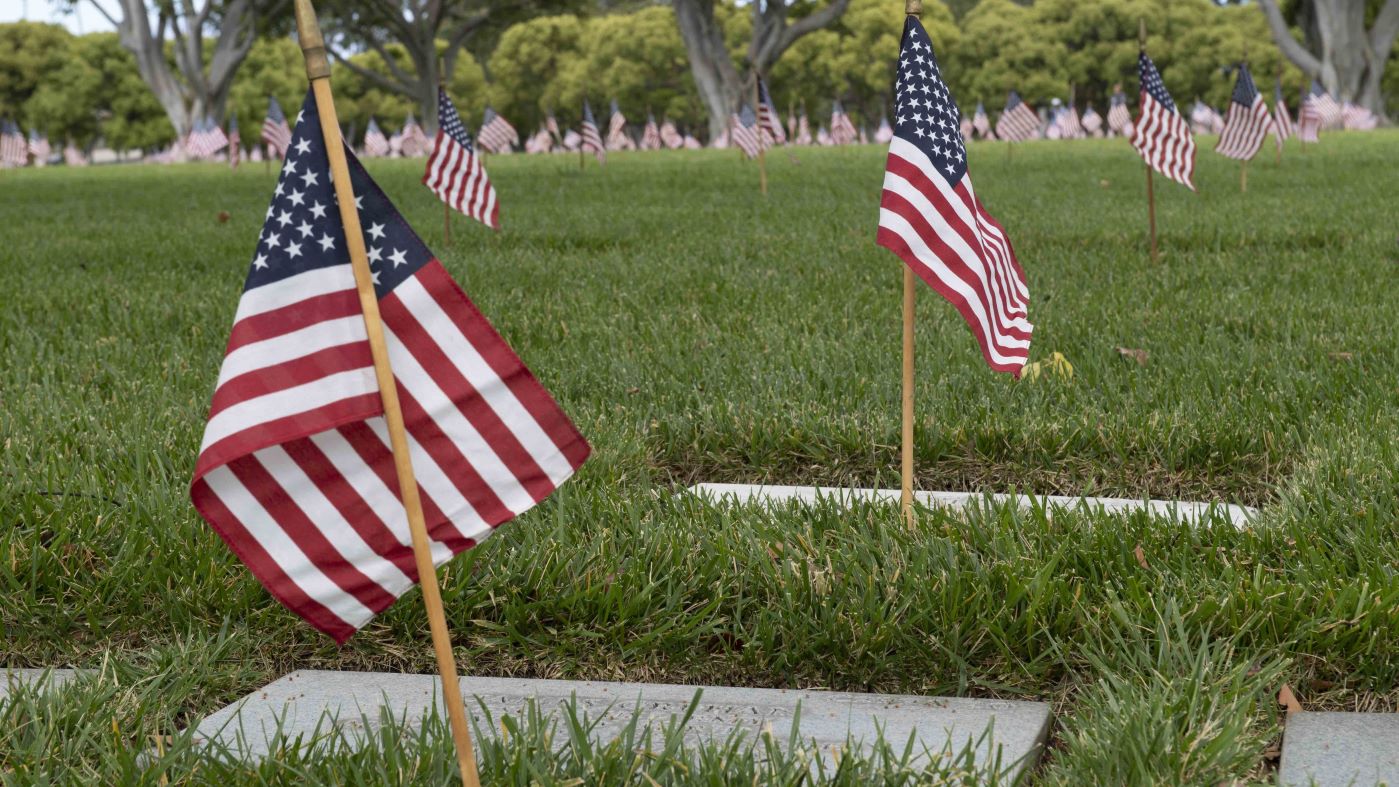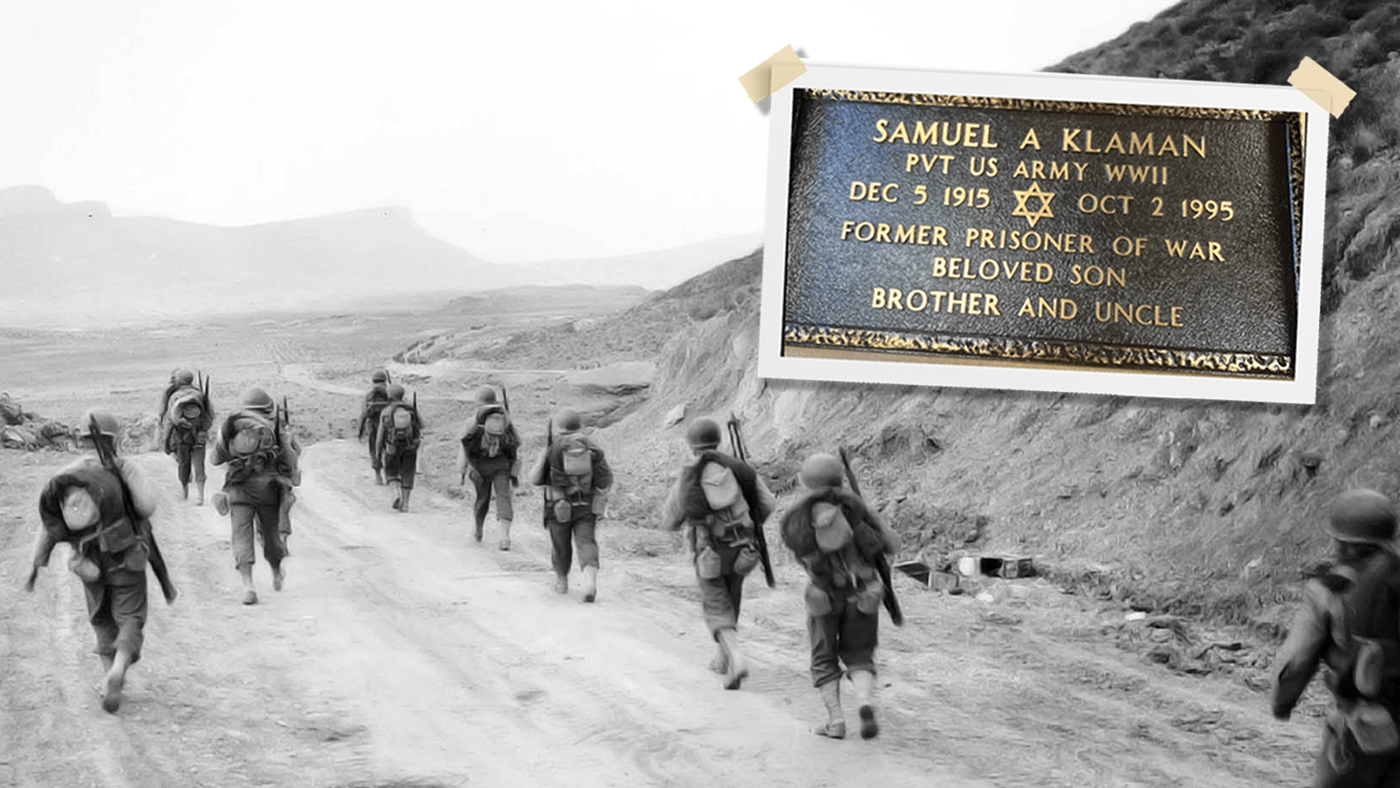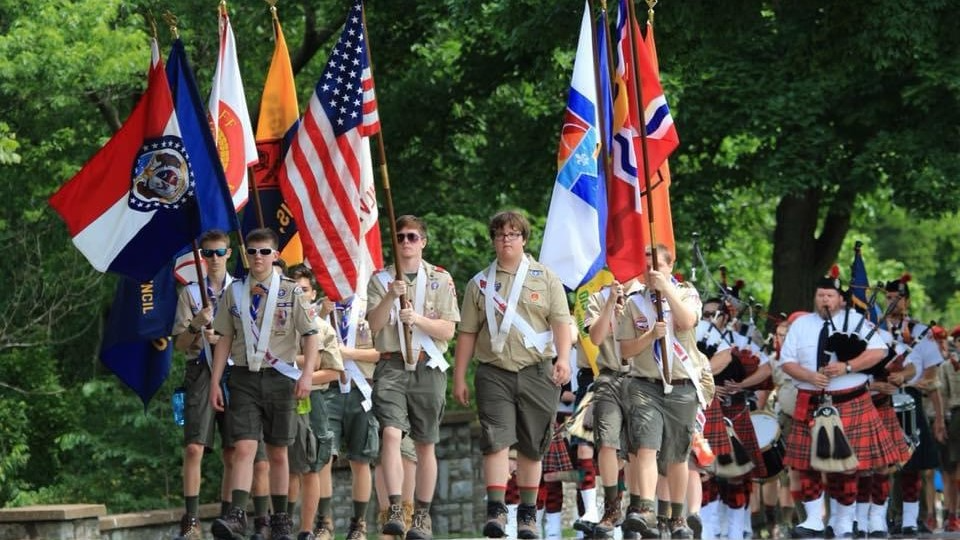
Figure 1: Stereograph image of Chattanooga National Cemetery, with hand mowing behind the visitors,1891.
May culminates with Memorial Day, established in 1868 for the nation to pause, to remember and honor deceased service men and women. Seasonally it is the start of summer and the annual chore of maintaining lush, green grass. The audible pitch of mechanical lawn mowers is unavoidable in suburban neighborhoods, at golf courses and parks, and cemeteries. A healthy layer of turf grass is the ideal backdrop for standard government marble headstones. So, May is also the busiest month for the National Cemetery Administration as it mows, trims, waters, fertilizes, and otherwise preens hundreds of thousands of acres of grass at the majority of its 136 national cemeteries to ready them for Memorial Day events.
The appearance of veterans’ graves at national cemeteries has changed over the years. Military procedures assured that the massive influx of interments in the late 1860s and early 1870s were placed into orderly landscapes. But requirements to maintain this honored terrain has advanced through technological inventions such as mowing and irrigation equipment.
Civil War-era burials in the first national cemeteries were arranged in rows or to create shaped sections in a larger design. Individual graves were mounded high with dirt and sprinkled with grass seed. Once mature, the so-called “well sodded” graves were both practical and temporary (Figure 3). As the contents of graves collapsed, the soil sank with it. The mounded graves are illustrated in contemporary images and are evoked by Henry Wadsworth Longfellow in the poem “Decoration Day” (1882): “Your silent tents of green / We deck with fragrant flowers / Yours has the suffering been, / The memory shall be ours.”
In 1873, new Army procedures called for sunken graves to be treated early in the year and filled “only to the general level of the ground. Before doing this, whatever turf is on the sunken grave will be taken off carefully in as large and regularly shaped pieces as practicable; and…the sod will be replaced upon the refilled grave.… The filling up of the sunken graves should generally be done in the early spring; and by careful attention to the resodding, these graves may be well clothed with green turf by the end of May.”
Mounded graves would have challenged any mechanical mower. Englishman Edwin Budding (1796-1848), a textile engineer, created the first mechanical push mower in 1830 by adapting the rotary used to trim carpet. In mid-century the device reached the United States and an estimated thirty-eight U.S patents for lawnmowers were issued between 1868 and 1873.
Going into the early 20th century, a national cemetery equipment inventory included hand, horse or “pony,” and power mowers (Figures 1-2).
Risk has always been associated with groundskeeping—injury to laborers and damage to headstones. The 1911 National Cemetery Regulations directed, “Care will be taken to avoid injury to monuments or headstones when cutting the grass” and “sickles or shears” should be used in those areas and “along the drives and walks which can not [sic] be reached with lawn mowers.” About this time, the Quartermaster General used a list of national cemeteries to inventory existing equipment, and the hand-written entries include several “H [horse] mowers,” other mowers and related field equipment (Figure 4).
Gas-powered lawn mowers were introduced in the 1920s after the automobile. But after World War II the desirable lawns associated with massive suburban development were achieved and maintained through the proliferation of gasoline-powered mowers and advancements in fertilizers, irrigation, and grass-seed. The National Cemetery Regulations, revised 1947, spelled out army priorities: “A well-kept lawn and properly located trees and shrubs are considered of greater importance, and contribute more to the beauty and maintenance of the cemetery than the promiscuous distribution of flower beds.” The same year, Seven Pines National Cemetery in Virginia purchased a Toro 30 Power Mower for $372.77.
Complementing suburban growth and growing leisure time filled with golf and baseball – all dependent upon green grass – Lawn or Memorial Park cemeteries are level expanses with low or flat markers framed by turfgrass. The federal government first authorized flat markers in 1948 for the National Memorial Cemetery of the Pacific; starting in 1976 their use was broadly expanded, citing the advantages of cost, size, and weight. In the 1980s, flat markers were justified because they “allow VA to maintain the pleasing appearance of national cemeteries more effectively” than uprights. “With upright stones a large riding mower is used to cut grass across the graves, a smaller mower between the stones, and yet another machine for grass immediately around the stones themselves. With flat markers, the grass can be mowed in one operation, without damage to the markers.” The popularity of flat markers has fluctuated over the years, but today they are exclusively used in nine sites, and 78 other NCA cemeteries use them in some burial sections.

Figure 4: Quartermaster General inventory of equipment – with the number of horse and other mowers – partial list, 1910. National Archives.
Most of the nineteenth-century obstacles to creating a healthy and attractive memorial landscape have been overcome. Grave liners, introduced as a standard element of national cemetery development in the 1980s, have eliminated sinking gravesites. Irrigation systems were initially installed in some national cemeteries in the 1980s with mixed results, but in more recent years they are increasingly added to historic and all new cemeteries to promote turfgrass to national shrine standards. NCA briefly piloted the limited use of artificial turf in cemetery assembly and similar areas – subsequently eliminating the need to mow at all – but that concept remains in limited use.
“By far, May is the busiest mowing month for NCA,” says Artie Perkins, a retired former employee who prepared Long Island National Cemetery, New York, for Memorial Days from 1980 to 2015, and who enthusiastically shared his insights. “The vast majority of mowing” at national cemeteries is accomplished by contractors now, but system-wide, NCA field personnel astride more than 500 mowers still have their work cut out. The typical green carpets range from Bluegrass to Bermuda, Fescue, and Perennial Rye grasses. The longest mowing season, in the South, is year-round; elsewhere it ranges from 32 to 38 weeks per year.
To appreciate Memorial Day through the development and maintenance of turfgrass at national cemeteries may serve a small niche audience as a minor historical tangent. In contrast, Carl Sandburg, an American writing during World War I about the fallen at celebrated battles, elevates grass into a voice, into a poem that reminds readers to always remember and honor this sacrifice.
“Grass”
Pile the bodies high at Austerlitz and Waterloo.
Shovel them under and let me work—
I am the grass; I cover all.
And pile them high at Gettysburg
And pile them high at Ypres and Verdun.
Shovel them under and let me work.
Two years, ten years, and passengers ask the conductor:
What place is this?
Where are we now?
I am the grass.
Let me work.
Story by Sara Amy Leach, Senior Historian, National Cemetery Administration.
Topics in this story
More Stories
Beginning on Nov. 9, 2024, VA will accept applications for payment of a monetary allowance for privately purchased OBRs and for OBRs provided by a grant-funded cemetery, when the OBR is placed at the time of interment. This allowance may be paid for burials that occurred on or after the effective date of the new authority which is Jan. 5, 2023.
With help from VBA and NCA, an administrative correction honored a WWII soldier's service and Jewish identity.
This year marked the 75th year of the 2024 Gravois Trail Memorial Day Good Turn Boy Scout flag placing at every gravesite at Jefferson Barracks National Cemetery.









i am a vietnam veteran and enjoy these articles thank you